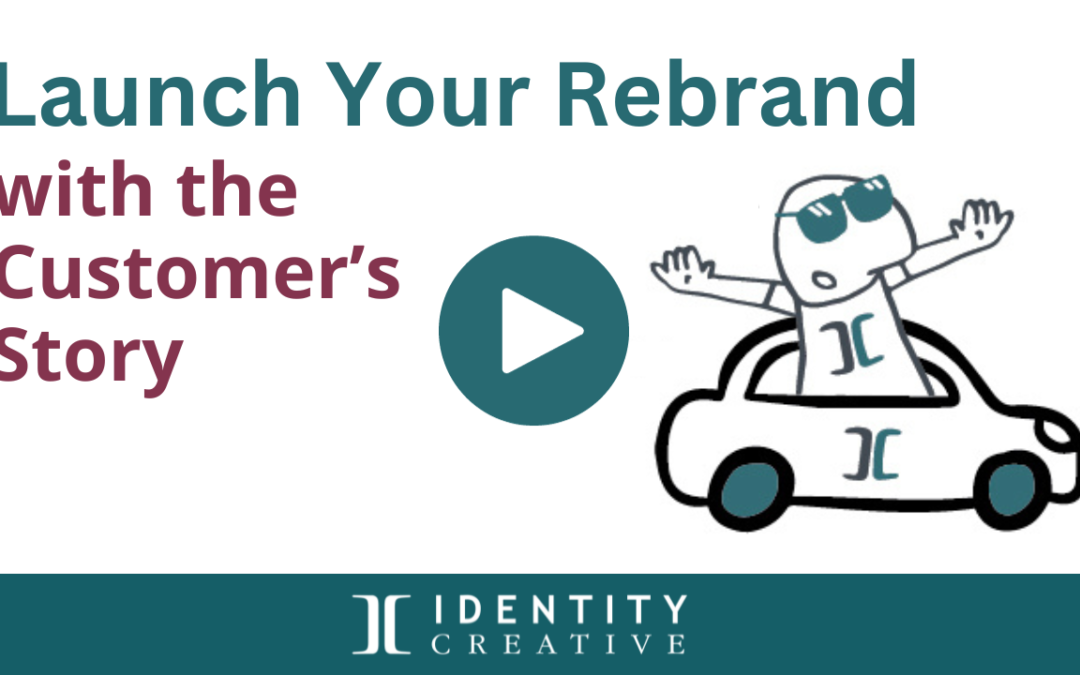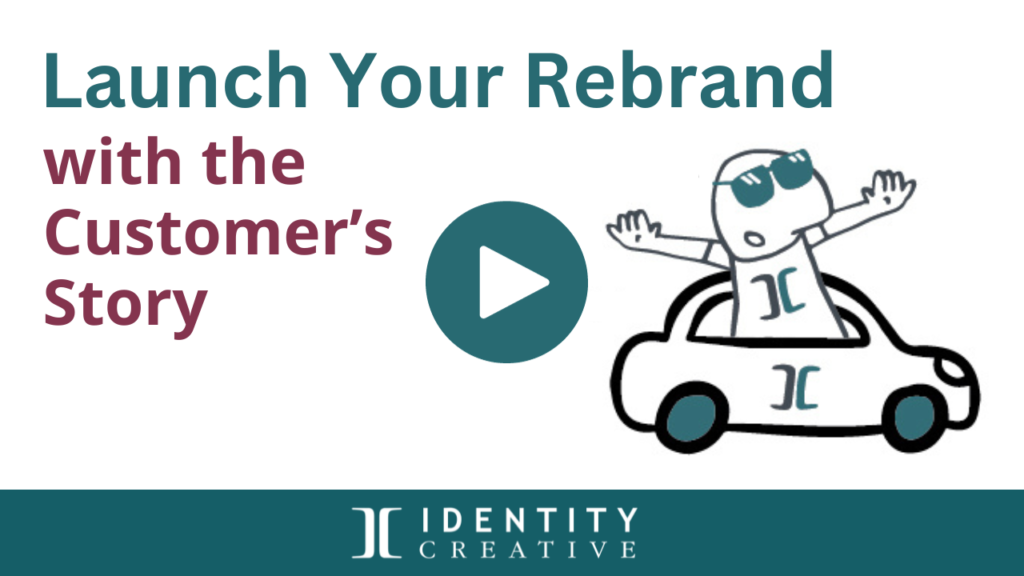Announce your new logo rebrand with the customer’s story (not yours!). When you rebrand, leverage this unique event with a story that resonates with your ideal customer.
Let’s be candid: no one outside of your company thinks the announcement of your new logo is breaking news.
Your logo is vitally important: it’s the face of your business and the foundation of your brand’s look and feel. But merely announcing, “We have a new logo!” wastes this opportunity to gain ground in the marketplace.
Launch Your Rebrand with the Customer’s Story
When you want to find a way to connect with your customers and how you uniquely solve their problem, what better way than with a story?
What would it be like if your rebranding announcement included a story your customers and prospects could relate to? Its impact would be far greater than announcing your new logo with a list of your company’s selling features.
Recorded history demonstrates that storytelling has been a central part of the human experience. Stories engage, inspire, and motivate people quickly. Good stories connect emotionally, are memorable, and motivate people to act.
Our Rebranding Story
In 2014, we rebranded because our name, Identity Graphic Design, no longer reflected the depth of value we were delivering to our clients. We had become much more involved with brand strategy development, creative messaging, and marketing campaigns through a variety of media. So, we changed our name to Identity Creative. (Choosing the new name is a story in itself!) The rebranding process included:
- Hiring an attorney to trademark our business name
- Negotiating the price to buy the identitycreative.com URL
- Building a new website
- and, of course, a new logo.
The Doctor Became the Patient
Going through the process ourselves gave us fresh insight and an improved understanding of our clients’ experience. Changing a business name is more complicated than I had imagined. From updating legal and tax status to overhauling all social profiles, it can be a time-consuming affair.
Another downside we did not anticipate was that we lost ground with organic search results by changing our URL with a redirect from identitygraphicdesign.com to identitycreative.com.
Creating Our Rebranding Story
Announcing a rebrand opens minds by adding the word “New.” Many studies have demonstrated that the word “new in a marketing campaign attracts the viewer. That’s why you’ll see things like “New Look!” on a cereal box. The campaign runs for 6 months, and sales tick up for the same product inside the box. Take advantage of your new name and logo with a story that business owners and marketing directors could relate to.
Our goal was to capture the emotion of our customers’ business owners and marketing directors’ problems and help them see the foundation of good branding.
Telling The Customer’s Story
As we brainstormed ideas, we put ourselves in our customers’ shoes. We looked back at the issues our clients were facing with outdated brands. While no two stories are the same, there are common themes and frustrations people experience when looking for a rebranding resource, choosing the right team, going through the process, and launching their new brand.
Here’s a Story About Telling a Customer’s Story. Seven Lessons I Learned:
LESSON 1 – Decide the format and distribution channels.
Instead of putting our faces in front of a camera again, we decided to try a new tool called VideoScribe to create a simple animated video. In 2014, it was pretty new, and we thought we’d give it a whirl.
We would publish a short 2-3 minute video on YouTube, Social Media pages, and our website. (TikTok wasn’t on the scene at the time.)
LESSON 2 – Nail the Plot and Key Characters.
Every good story has a plot, with, simply stated, a thesis (status quo), antithesis (argument against the thesis), and synthesis (resolution).
Good stories develop believable characters, a hero, villain, and sage who create tension that challenges the status quo. The hero of every good story is facing a problem and conquers it.
In one of our brainstorming sessions, I talked about the frustration I hear from business owners who feel unclear about how to approach branding. They don’t know where to start.
We wanted to use an analogy for their business. A fruit tree works because it bears fruit (a product), grows, needs nurturing and pruning, and faces internal and external challenges.
As I described my “frustrated business owner,” Jeremy Munsterman, gifted illustrator, designer, and branding creative, picked up a Dry-Erase marker and drew a character on our board.
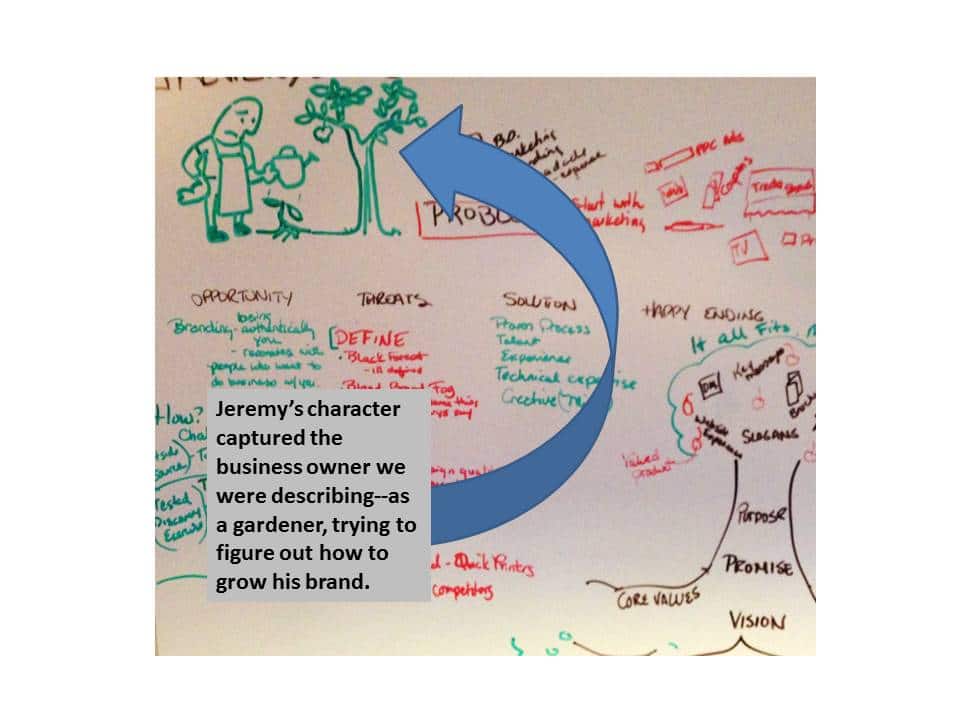
We loved the guy! The emotion Jeremy captured on his face and his plight to grow a brand-tree that would stand taller than his competitor’s was perfect. We had our hero and named him Ben. Jeremy would illustrate and, with VideoScribe, would create the compelling story we wanted to tell.
LESSON 3 – A good story triggers a parallel emotion.
Writing the story was my job. It should have been easy because my ideas were bubbling over. But it was more challenging than I would have imagined.
Developing characters, setting the scene, creating a plot, and wrapping it all up in a 3-minute animation was inconceivable for me. How could I set the context, tell the story, and engage my audience emotionally in such a short time? Emotional connection is vital.
David Hutchens, best-selling author, explains the importance of emotional connection: “Neuroscience shows that when you include emotional content in your story, it triggers a parallel emotional experience in your listener. This phenomenon is called neural coupling…(which) makes your story much more engaging.” Through tone & language, I needed to remember how I wanted my audience to feel.
LESSON 4 – Put yourself in the seat with the audience.
In every step of the story-making process, we kept asking ourselves:
- Would we gain the precious interest of our audience with this?
- Would professionals in the B2B space want to watch it?
- Why would they be interested in this story?
- Is the intro compelling enough to stick through to the end?
Initially, I wrote a script that would require a 15-minute animation. It was too long. It also had too much industry jargon that wouldn’t resonate with people.
It’s easy in any message we want to give, personally or professionally, to think about what we want to say rather than what our listeners care about and how they will respond.
Our rebranding story needed to be written from the vantage point of our intended audience. Working with so many business owners and marketing directors over the years gave us content we could glean from their experiences.
LESSON 5 – Seek criticism, not praise.
After editing and cutting to create a shorter version, it was still too long, 11 minutes (ugh). I needed outside help. So I did a rough audio and sent it to colleagues I respected and trusted would critique it with candor. Their feedback helped me red-line 5 more minutes of jargon, repetition, and tertiary content.
In his book Creativity, Inc., Ed Catmull describes the never-ending challenge of keeping the aphorism, “Story is King,” a reality at Pixar. He describes the work that takes place with a team of creators they’ve termed the Braintrust.
The Braintrust sets their egos aside and makes their work open to critique. The rigor of these sessions is key to bringing their stories to stammering box office hits. After my tiny effort to create and direct a very rudimentary animation, now, at the end of their films, I watch the credits with a new level of respect.
LESSON 6 – Trust talent and trim, trim, trim!
We hired Chris Otto to be our voice talent. He has a degree in theater (U of M) and has worked in Broadway productions and film. He has a great voice and a serendipitous sense of humor with a contagious laugh. I was grateful to have him on our team.
In his first reading, he red-lined 8 minutes from my script! It was hard to see those 8 minutes of well-worked dialogue hit the “cutting floor.” But Chris was right when he said it would lose people. Chris is able to zero in on the plight of a character and the heart of the message.
With Chris’ humor and talent, he made the story feel natural. Chris positioned the IC character as the guide without an explicit, over-moralized pitch.
Thanks to Chris, we were down to 3 minutes. (Hurrah!) Our next step was to re-work the storyboard. We were finally ready for Jeremy to import his character illustrations created in Adobe Illustrator into VideoScribe.
Everything should have been coming together at this point, but it wasn’t. VideoScribe was not as expanded as it is now, and we had gaps in the visual interest of our story. Enter our faithful video team. Matthew Kleist’s video company, MODI, was in its infancy, and they helped us out by transferring the mp4 file to AfterEffects, he was able to create interest in the spaces where nothing was happening.
The video was completed a bit behind schedule, but alas, Brand Envy: A Brand Tree Story was published.
LESSON 7 – Stay the course, keep learning, and you’ll find happy surprises.
As creatives, we had brainstormed many ideas that we thought were brilliant. The challenge was the execution to bring our brilliant concepts to life.
During this project, I hit a low point and thought I’d invested a decent amount of effort on something I was ready to ditch. Instead, we pressed on. We intended to create a short, simple, low-budget animation that was relatable, and we succeeded.
Fun Surprises
Eight years later, of course, there are improvements we would make to the animations and effects. Even without these, the story of our character, Ben, still resonates. We might be biased here, but we think it is still a sweet two-minute, forty-second story worth watching.
We can look back at the fun memories and great connections with creatives. Another unanticipated bonus from this project was that we had a newfound friend, a company mascot named “IC.”
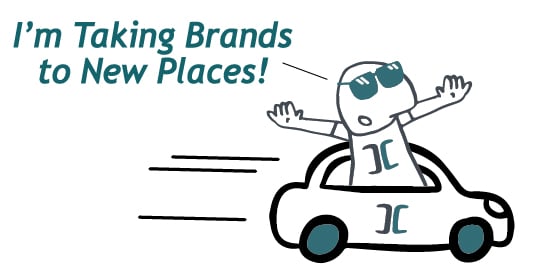
We have expanded the IC character’s world with Jeremy on call. He’s fully launched into his career and generously continues to share his illustration talents with us.
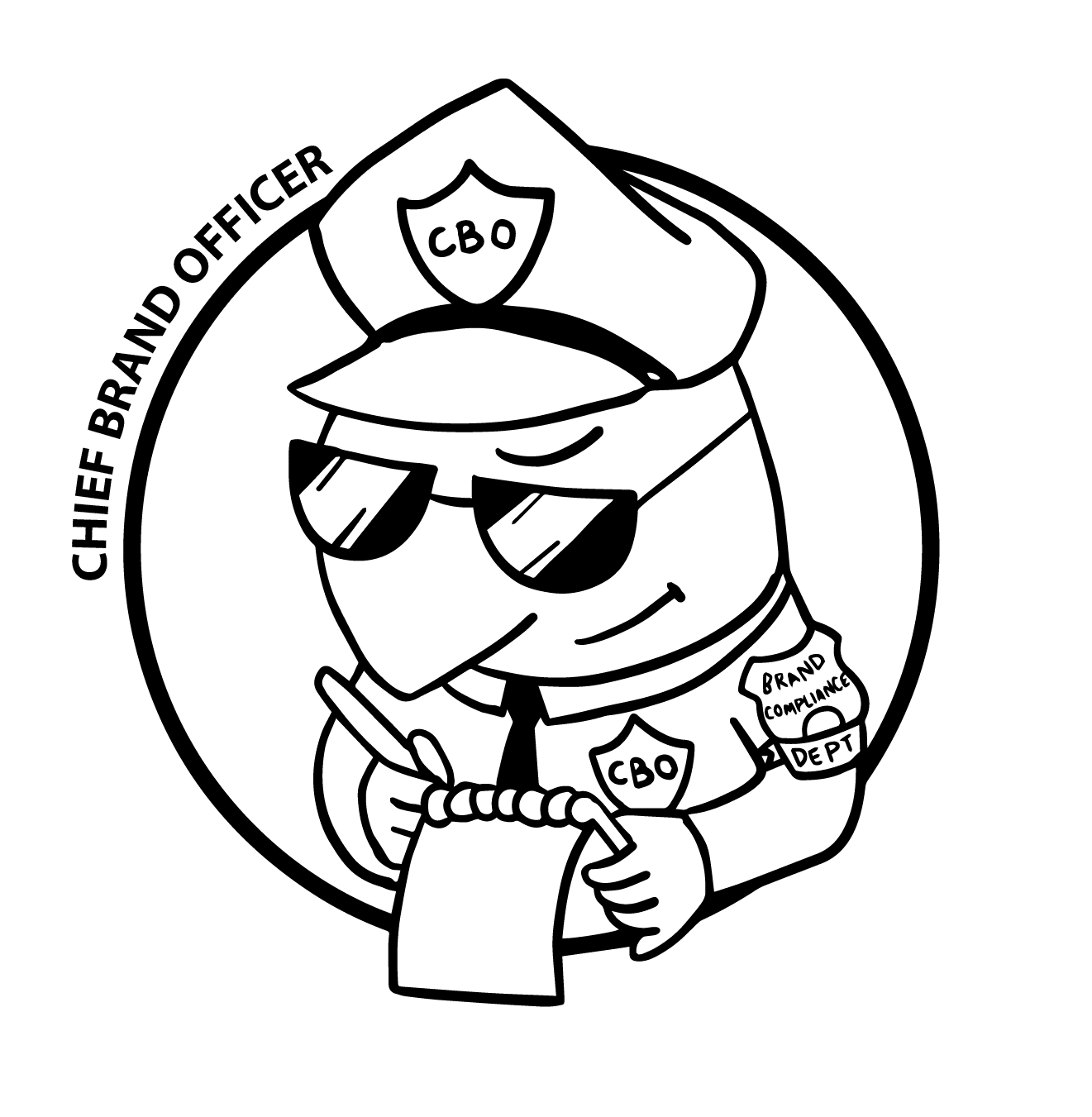
Before branding:
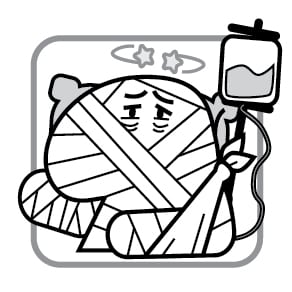
After a brand Refresh:

Storytelling is an art.
Telling our customer’s story was a challenge. It’s WAY easier to help our clients tell a story that relates to their customers. We implement Don Miller’s StoryBrand framework to help our clients get inside their customers’ worlds and create a relatable message.
Do you have a story about telling a story? Tell us in the comments below!

